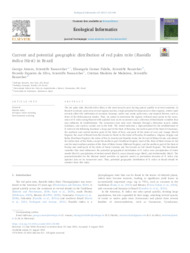Current and potential geographic distribution of red palm mite (Raoiella indica Hirst) in Brazil.
Current and potential geographic distribution of red palm mite (Raoiella indica Hirst) in Brazil.
Author(s): AMARO, G. C.; FIDELIS, E. G.; SILVA, R. S. da; MEDEIROS, C. M. de
Summary: The red palm mite, Raoiella indica Hirst, is the most invasive pest, having spread quickly to several countries. In Brazil it is already present in several regions and has a high potential for dispersion to other regions, which could severely affect the cultivation of coconuts, bananas, native and exotic palm trees, and tropical flowers, such as those of the Heliconiaceae family. Thus, we aimed to determine the regions of Brazil most prone to the occurrence of R. indica using Maxent with updated data on its occurrence and a selection of bioclimatic variables that may influence its establishment. The occurrence data used were obtained through a literature search, online databases, and surveys carried out in the field. The model indicated a high potential for the establishment of R. indica in the following locations: a large part of the State of Roraima, the eastern part of the State of Amazonas, the northern and central-western parts of the State of Par´a, and parts of the states of Acre and Amap´a (North Region); the coast of Brazil from Rio Grande do Norte to the states of Paraíba, Pernanbuco, Alagoas, Sergipe and Bahia (Northeast Region); the states of Rio de Janeiro and Espírito Santo, the far east of Minas Gerais, and almost the entire state of S?ao Paulo, except the northern part (Southeast Region); most of the State of Mato Grosso do Sul and the most southern portion of the State of Mato Grosso (Midwest Region); and the northern part of the State of Paran´a and small parts of the states of Santa Catarina and Rio Grande do Sul (South Region). The bioclimatic variables that most influenced the potential geographical distribution of R. indica were precipitation of driest month (Bio14), precipitation of wettest month (Bio13), mean diurnal range (Bio2), and isothermality (Bio3). The parameterization for the Maxent model provides an updated model to prevention invasion of R. indica due updated data on its occurrence used. Thus, potential geographic distribution of R. indica in Brazil should be consider from this study.
Publication year: 2021
Types of publication: Journal article
Unit: Embrapa Roraima
Observation
Some of Embrapa's publications are published as ePub files. To read them, use or download one of the following free software options to your computer or mobile device. Android: Google Play Books; IOS: iBooks; Windows and Linux: Calibre.
Access other publications
Access the Agricultural Research Database (BDPA) to consult Embrapa's full library collection and records.
Visit Embrapa Bookstore to purchase books and other publications sold by Embrapa.

